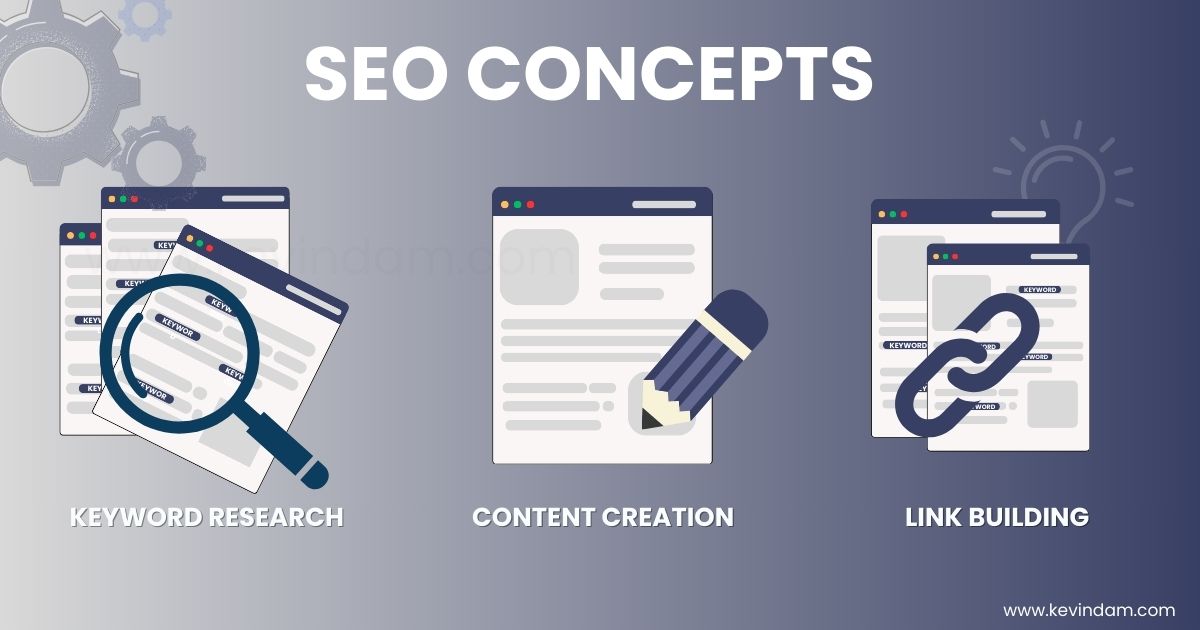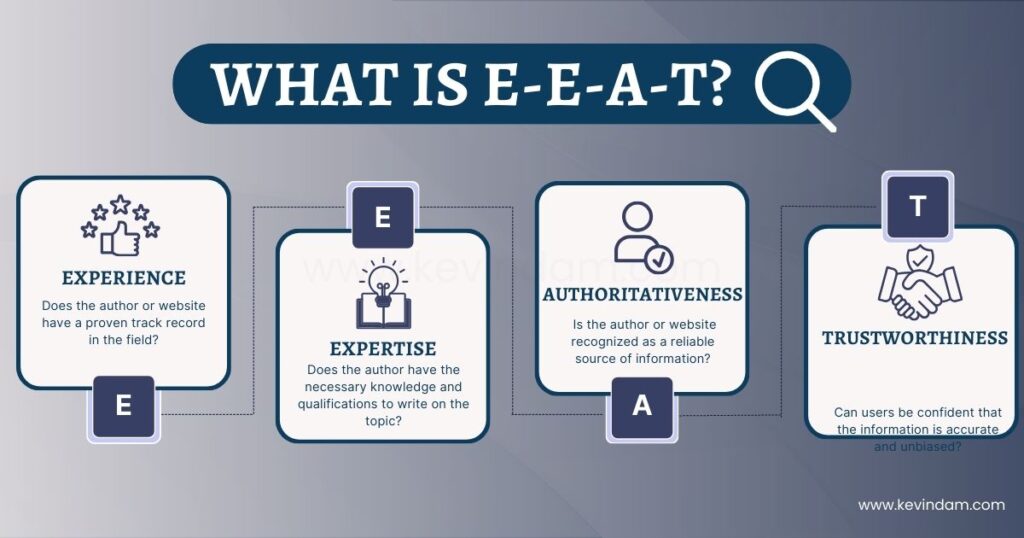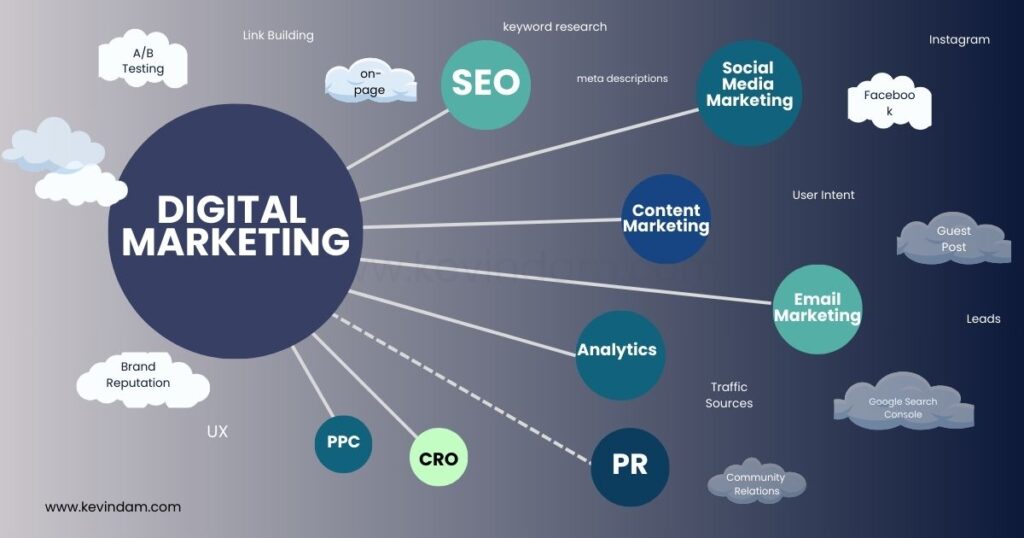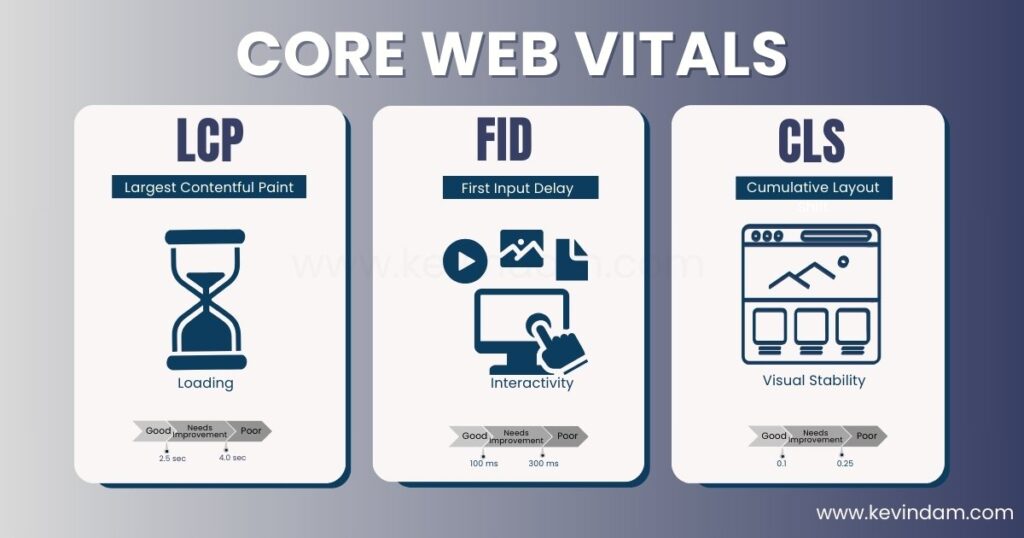
Last Updated August 14, 2024
SEO Concepts Every Website Owner Should Know in 2024
Imagine you’ve crafted the most visually stunning website, but it’s unseen by your potential audience. The key to boosting visibility lies in mastering Search Engine Optimisation (SEO).
SEO improves website performance, experience, and authority for better search engine visibility. This article covers key SEO concepts for website owners in 2024, including keyword research, on-page and off-page optimisation, and creating high-quality content. It also explores advanced topics like E-E-A-T, Core Web Vitals, and mobile-first indexing. Understanding and applying these principles can enhance site visibility and performance in search results.
Why is SEO so important?
A report reveals that 45.1% of desktop users prefer clicking on organic search results, compared to just 1.8% who choose paid advertisements, usually positioned at the top of the search page. To generate an equivalent amount of traffic through Google Ads it would cost a company approximately $336.9 million.
For website owners who don’t have a large budget for ads, SEO would come in handy. Understanding SEO concepts is critical for website owners. It allows you to strategically organise your site components to encourage search engines to favour and prioritise your website. An effective SEO can drive engagement, conversions, and revenue, improving visibility and ranking on search engine results pages (SERPs).
This article aims to clarify the latest SEO concepts that every website owner should know. From keyword research, E-E-A-T, and technical SEO like Core Web Vitals, Mobile-First Indexing, etc. This serves as a guide to enhance your organic search traffic, ensuring that your website, even if you are a beginner or seasoned digital marketer, doesn’t just exist but thrives in the online competition.
The Foundations of SEO
Search Engine Optimisation (SEO) is the art of elevating the quality and quantity of website traffic through organic search engine results. Understanding these concepts is vital to gaining a competitive advantage in online visibility and digital marketing success.
SEO Process Flowchart:

- Audience Analysis
Knowing your target audience is the first step. This ensures that your content resonates and is engaging. Accessible and user-friendly content, coupled with a smooth website design, will help to create a positive user experience and better search engine visibility. - Keyword Research
Researching and identifying the right keywords is key to attracting your target audience.
There are a few key factors to consider when determining the keywords you want to target on your site, such as search volume, keyword difficulty and relevance to your website’s content. Conduct thorough keyword research using tools like Google Keyword Planner or SEMrush to identify high-performing keywords that align with your audience’s search intent. - Content Ideation and Creation
Based on your keyword research, brainstorm ideas that will engage and inform your target audience. This includes different types of content like blog posts, infographics, videos, or any other type that aligns with your keywords and addresses the needs of your audience.
Creating high-quality, valuable content is crucial for SEO. Integrating targeted keywords and phrases can attract users and boost your website’s visibility in search engine results pages (SERPs). To optimise your content further, make it scannable with bullet points and well-structured header tags (H1–H6) for search engines. Enhance the user experience by incorporating relevant images or videos into your content. - Onpage Optimisation
Optimising on-page elements such as title tags, meta descriptions, headings, alt text, and URLs with targeted keywords helps search engines understand the relevancy of your content. In addition, optimising images with relevant alt text and using internal linking can also improve SEO.
Once your content is created and optimised, it’s time to publish it on your website. Make sure to include social sharing buttons, as well as a call-to-action to encourage readers to share your content on their own platforms. This drives organic traffic to your content. - Link Building
Building strong backlinks from reputable websites is a crucial part of SEO. These links signal to search engines that your website is a trusted source of information and can improve. - Performance Monitoring
Tracking the performance of your content aids user experience and search engines in indexing pages. This helps understand what resonates with your audience and what may need adjustment. Use tools like Google Analytics or other SEO analytics software to monitor page views, engagement rates, bounce rates, and conversion rates.
Remember, balancing what appeals to the audience and what satisfies search engine algorithms is key. Avoid tactics like keyword stuffing that compromise content quality. Instead, aim for organic traffic through value-driven content and strategic optimisation.
SEO Concepts You Need to Master
SEO is always changing. To beat the competition, mastering SEO means more than just basic keyword stuff. Understanding keywords down to technical aspects helps improve your site’s visibility and gives users a great experience. Here are the key ideas to understand:
Keyword Research and Clustering
Keyword Research is the foundation of any successful SEO strategy. It involves identifying the most relevant and high-traffic keywords your target audience is searching for. Once you have a list of keywords, you can cluster them into groups based on their relevance and intent. This helps in creating focused content that not only ranks well in search engine results but also meets the user’s search intent.
To effectively use keyword clustering:
- Perform extensive keyword research to identify relevant search queries.
- Group keywords with similar search intent.
- Create content that comprehensively covers the topic, incorporating the clustered keywords to build authority on the subject.
Creating User-Centric Content
Understanding your audience is paramount to creating user-centric content. The goal is to address their concerns, answer their questions, and engage them meaningfully. High-quality content is the most important ranking factor, and it needs to be:
- Written in a clear and concise manner.
- Structured with headings, lists, and bullet points for easy reading.
- Responsive, rendering well on various devices and screen sizes. Improving site navigation and user experience should be a continual process based on user feedback and behaviour analysis tools.
Long-Form Content
Long-form content has a significant impact on SEO, as it tends to cover topics thoroughly, fulfilling the user’s search intent and keeping them engaged on the site for longer periods. This detailed content often results in higher search engine rankings because it is seen as more authoritative and valuable. Additionally, comprehensive articles have more opportunities to naturally incorporate relevant keywords and phrases, which can help in ranking for a variety of search queries.
SEO Benefits of Long-Form Content:
- Improved user engagement.
- Lower bounce rates.
- Higher potential for backlinks.
- Increased social shares.
- More comprehensive keyword inclusion.
- Better satisfaction of user intent.
- Greater visibility in search results.
- Enhanced click-through rates (CTRs).
In essence, long-form content can lead to better performance in search results and is a valuable element of effective SEO strategies.
Providing Image Alt Text
One often overlooked but critical aspect of SEO involves providing proper image alt text. Alt text, short for alternative text, is a written description of an image that is displayed if the image file is not loaded. It is also used by search engines to understand the content of an image.
How Image Alt Text Affects User Experience:
- Accessibility: For users with visual impairments relying on screen readers, alt text provides a contextual description, making the web more inclusive and navigable.
- Technical Issues: In cases where images fail to load due to slow connection or technical errors, alt text ensures the user still receives information regarding the visual content.
- SEO Benefits: Search engines crawl and index alt text, contributing to how relevant a page is to search queries, potentially improving organic traffic.
Best Practices for Crafting Image Alt Text:
- Be descriptive and concise
- Include target keywords when relevant
- Avoid keyword stuffing
- Reflect the image context within the content
Providing image alt text, therefore, is a multipurpose practice that enhances the user experience while simultaneously supporting the SEO goals of improved site visibility and accessibility.
On-page vs. off-page optimisation
On-page Off-page optimisation involves external factors, including backlinks, social media presence, and influence marketing.
Onpage optimisation refers to factors on your website that you can control directly, such as content quality, title tags, and internal linking. It involves optimising individual web pages to rank higher and earn more relevant traffic in search engines. Two critical elements of on-page optimisation are title tags and meta descriptions.
- Title tags are HTML elements that specify the title of a web page. They play a significant role in helping search engines understand what your page is about, as well as allowing users to quickly identify the content.
- Meta descriptions provide a concise summary of a page’s content—the text displayed under the title tag in search results. Crafting compelling meta descriptions can influence whether a user clicks through to your website or not.
Off-page SEO pursues high-quality backlink opportunities and active social media engagement. This refers to actions taken outside of your own website to impact your rankings within search engine results pages (SERPs), which includes guest posting, Help-A-Reporter-Out (HARO) and Influencer Outreach.
Link building is a prominent off-page SEO strategy that involves acquiring backlinks from other websites to your own site. High-quality backlinks act as votes of confidence for your website, indicating to search engines that your content is valuable and worthy of citation. However, it’s important to prioritise quality over quantity regarding backlinks.
E-E-A-T: Enhancing Content Credibility and Authority

Google emphasises the importance of Expertise, Authoritativeness, and Trustworthiness (E-A-T), and recently expanded to include Experience (E-E-A-T).
According to a report, people frequently make life-changing decisions influenced by online content, so promoting material that lacks E-E-A-T criteria may endanger individuals and their communities and jeopardise both Google’s credibility and its ability to serve communities effectively.
To determine E-E-A-T, Google deploys a team of Search Quality Raters that are tasked with evaluating ranking sites following every algorithm update. But this doesn’t mean it’s a ranking factor. Search Engine Land says there’s no way to identify a high E-E-A-T website. But still, you need to enhance your content’s credibility and authority through these:
- Include credentials and clear authorship.
- Cite authoritative sources and incorporate reliable data.
- Ensure content is consistently updated and factually accurate.
- Encourage reviews and testimonials to boost trustworthiness.
- Build relevant links.
Semantics and Content Structuring
Semantics in SEO relates to the meaning and relationship of words within your content. A strong semantic structure helps search engines understand context and intent, enhancing content discoverability. To benefit from semantic SEO:
- Use synonyms and related phrases naturally.
- Structure information in a logical order.
- Incorporate schema markup to help search engines interpret the content.
Knowledge Gap, Semantics, and Entities
Understanding the intricate concepts of entities and their relationships within content can significantly enhance SEO. By properly identifying and connecting entities in your content, search engines can better comprehend the subject matter and its relevance to specific search queries.
Here’s a brief breakdown:
Knowledge Gap
- Search engines strive to fill the knowledge gap between user queries and the most fitting content.
- Recognising this gap helps businesses provide targeted information that aligns with user intent, which is key to SEO success.
Semantics

- Understanding semantics—the meaning behind words and phrases—allows for the creation of content that search engines can easily relate to user inquiries.
- Semantic SEO involves strategically using contextually relevant keywords and phrases beyond the target keyword, bolstering the context for search engines.
Entities and Relationships
- Identifying entities and illustrating how they interrelate enhances content structure and helps search algorithms ascertain content validity.
- Establishing clear entity relationships strengthens topical authority, which is favourable for SEO.
By closing the knowledge gap with semantic understanding and clear entity relationships, SEO can be optimised to not only attract more organic traffic but also to deliver a user experience that search engines reward with higher rankings.
Contextual Layers and Predicates
Modern SEO strategies employ deeper semantic analysis to understand the context and intent behind search queries. As search engine algorithms become more sophisticated, they place a higher value on the relevance and context of content than just the presence of specific phrases.
Contextual Layers in SEO:
- Topic relevance: Ensures content covers a topic comprehensively.
- Searcher intent: Aligns content with the reason behind a user’s search query.
- Content depth: Addresses related subtopics, synonyms, and questions.
| SEO Predicates | Role in Contextual SEO |
| Keywords | Signal the core topic and possible user intent. |
| Latent Semantic Indexing (LSI) | Helps in recognising the topic’s context through related terms. |
| Entity Salience | Identifies key subjects within the content and their importance. |
Understanding these concepts allows business owners and digital marketers to refine their SEO strategies to produce high-quality content that resonates with search engines and users. This approach leads to more organic traffic with better engagement and potentially higher conversion rates. Remember, SEO now demands that content is not just filled with target keywords but also seamlessly serves user intent and topic relevancy.
Hypernyms and Hyponyms
In the realm of SEO, leveraging word relationships in content creation can significantly enhance relevance and cater to search engine algorithms. Hypernyms and hyponyms are tools that can assist in this.
A hypernym is a word with a broad meaning that encompasses various more specific words known as hyponyms. For instance, “vehicle” is a hypernym, while “car,” “truck,” and “motorcycle” are its hyponyms.
Incorporating these word relationships into content helps to create a semantic field that search engines can use to determine the relevance of a page to user queries. When search engine algorithms detect a rich array of related terms and concepts, they’re more likely to view your content as comprehensive and authoritative on the topic.
To best leverage hypernyms and hyponyms, consider the following tips:
- Use hypernyms to establish the general context and introduce broader themes.
- Employ hyponyms to go into specifics, providing detailed information that satisfies user intent.
- Create a natural flow between hypernyms and hyponyms, avoiding any forced or artificial insertion of terms.
Mindfully blending these words within your content can enhance your SEO efforts and improve overall content relevance to users and search engines.
Optimising for Rich Snippets and Structured Data
Rich snippets enhance your visibility in the search results by providing additional data points like ratings, prices, or author information. Structured data, on the other hand, helps search engines index and understand the content of your pages. To optimise for these:
- Use structured data markup, such as JSON-LD, to inform search engines about the specifics of your content.
- Test the markup with tools like Google’s Rich Results Test
Core Web Vitals

Core Web Vitals are a set of specific factors that Google considers important in a webpage’s overall user experience. These include how quickly a page loads (LCP), how quickly it becomes interactive (FID), and the stability of the content as it loads (CLS). Graphs indicating the negative impact of high load times on bounce rates underscore the importance of optimising these vitals.
Mobile-first Indexing
With the increasing trend of web access via mobile devices, Google has shifted to mobile-first indexing. This means Google predominantly uses the mobile version of the content for indexing and ranking. A site must be mobile-responsive, with comparable content and structured data on both desktop and mobile versions, to stay competitive.
Conduct a Site Audit
Performing a site audit is like a health check on your website. It involves analysing your website to identify areas of improvement and ensure that it is optimised for search engine visibility. Some important aspects to consider during a site audit include:
A thorough SEO audit helps identify strengths, weaknesses, and opportunities for improvement on your website. The process involves:
- Submitting sitemaps for easier crawlability.
- Reviewing site structure and content for SEO efficiencies and deficiencies.
- Analysing backlinks and online presence.
- Identifying technical issues like broken links and page speed concerns.
Leveraging Machine Learning and Automation
With technological advancements, many SEO tools now incorporate machine learning to optimise strategies. These tools can predict trends, suggest keywords, and offer insights into competition. Automation can greatly enhance efficiency by allowing repetitive tasks to be managed with less human intervention.
Practical SEO Tools and Software
Understanding SEO concepts is crucial for enhancing your website’s visibility and driving organic traffic. Let’s explore practical tools and software that can aid you in mastering these SEO essentials.
| SEO Focus | Description | Sample Tools |
| Keyword Research | These tools help identify relevant keywords for your website based on search volume, competition, and user intent. | Google Keyword Planner: An excellent starting point for finding relevant keywords.SEMrush: Offers comprehensive keyword data, including search volume and analysing the competitor keywords.Ahrefs: Known for its extensive backlink and keyword research capabilities.Moz: Full-service, all-around powerhouse tool, whether you are looking for keyword suggestions or want to crawl the website. |
| Content Optimisation | These tools analyse and optimise website content for better search engine visibility and user experience. | Yoast SEO: A popular WordPress plugin that helps optimise website content for search engines, providing suggestions for improvement.Clearscope: Helps ensure content relevancy for target keywords. |
| Analytics | These platforms provide data and insights into website performance, user behaviour, and organic search traffic. | Google Analytics: This free tool by Google provides insights into how visitors find your website, what pages they visit, and how long they stay. It helps you understand your audience and optimise your website for better engagement and conversions.Google Search Console: This tool helps you identify technical SEO issues that might prevent your website from ranking well in search results.Screaming Frog SEO Spider: This software crawls your website, identifying SEO issues such as broken links and duplicate content.Moz Pro: Provides site audits, keyword tracking, and much more |
| Site Audit and Optimisation | Screaming Frog: This software crawls your website, identifying SEO issues such as broken links and duplicate content.Google PageSpeed Insights: Assesses your website’s performance and suggests optimisations. |
Quick Guide:
- Choose a tool based on your specific need (keyword research, site audit, etc.).
- Follow the tool’s guide or tutorial for best practices.
- Implement the suggested changes to improve your SEO.
Tip: Regular use of Google Search Console helps monitor your site’s performance in Google searches, a must for every SEO strategy.
Conclusion
SEO is key to improving your website’s visibility and attracting more visitors. Understanding the key concepts from keyword research to technical aspects and using the right tools can greatly enhance your SEO efforts. Regularly auditing and optimising your site also ensures that it remains competitive in search engine rankings.
Keep in mind that SEO is an ongoing process, so it’s important to regularly review and make adjustments as needed to stay ahead
